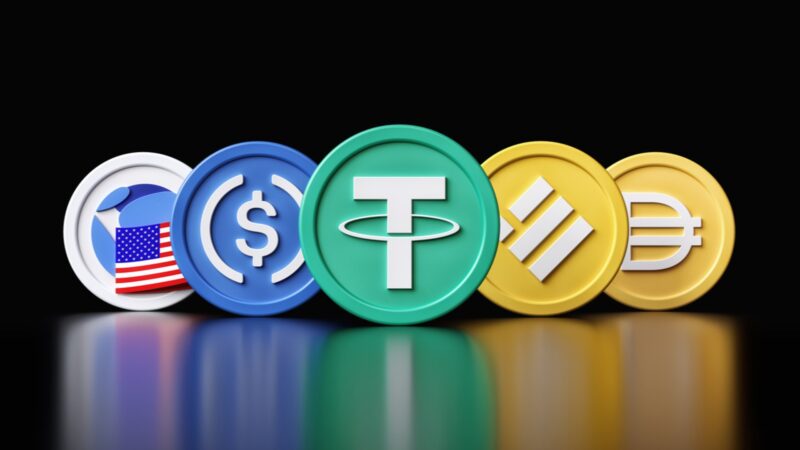After LUNA and UST collapsed, everyone’s been asking which stablecoins are safe and which ones are headed to zero. Well to answer this question I’ll rank the 12 most popular stablecoins and a tier list. This list goes from S to D tier with S tier being the absolute best stablecoins, and D tier being trash like I wouldn’t touch them even if they paid me to.
USDT(Tether)
This is by far the biggest and most popular stablecoin out there, but it’s also had a ton of criticism and fud over the years. It’s mostly because we can’t tell for sure if Tether is fully backed or not. For the longest time, they claimed that they were backed one to one by US dollars, but they later changed that to include a mix of cash, bonds, commercial paper, etc. They’ve also never done a real public audit before, which would pretty much end all the rumors if they did one and it confirmed their backing.
But honestly, I’ve never really been worried about tether. First, they have a doxxed team that keeps a pretty public profile, it’d be stupid of them to do something with Tether that could get them thrown in jail. They have all the incentives to take a more conservative approach and still make decent money but without the risk of getting in trouble. Also, Coinbase made a huge move in early 2021 when they added Tether to their exchange and that gave me even more faith in it.
Think about it, Coinbase has an army of lawyers, with all the fud surrounding Tether they best be sure that they did their due diligence before making that decision. Recently there were some rumors that Tether was holding risky commercial paper from Chinese or Russian entities that could default, but that’s quickly becoming a non-issue as Tether reduces its commercial paper holdings from 20 billion in May to 3.5 billion by the end of July. So one by one, all these concerns are getting addressed. I’ve always felt comfortable holding Tether even through times of brief volatility. I give them an A rating, not the absolute best but still very good.
USDD
This is Justin Sun’s baby aka TRON’s native stablecoin. He decided to make this because he was impressed by LUNA and UST’s growth before it all collapsed. Yes, USDD will have an on-chain swap just like LUNA and UST did, but that’s actually in phase four of their roadmap. They just started phase one recently so as of right now USDD is just a boring over-collateralized stablecoin, there’s no swap mechanism and hence there’s no risk of a death spiral.
They’re also super centralized right now, to swap TRON for USDD you have to be a white-listed institution and there’s currently no way to go back from USDD to TRX. That’s probably why it took them a while to recover from 95 cents to one dollar even though Justin had more than enough funds to bring it back to a dollar with a click of a button. With all that in mind, I give it a C right now because it just doesn’t have a strong value proposition, and I’d rather not rely on Justin with my money.
FRAX
This stablecoin combines both DAI and UST’s model. It takes a hybrid approach because you can mint FRAX by putting it in both USDC and FXS which is their version of LUNA. The ratio of USDC and FXS depends on something called the collateral ratio, sometimes you have to put in more USDC and other times more FXS. FRAX stands for fractional algorithmic so it’s not a full algorithmic stablecoin because it does have some hard collateral backing it. One thing that impressed me about FRAX is that their protocol owns a lot of convex tokens that give them the power to direct curved liquidity towards their stablecoin pool with DAI, USDT, and USDC. This is amazing for a young stablecoin like FRAX because joining a pool with those established players can help smooth out its volatility.
One issue with FRAX is that they are trying to be a decentralized and permissionless stablecoin but with such heavy reliance on USDC they’ll always run the risk that their collateral could be frozen one day for whatever reason. I’m going to put FRAX in the B tier because it is innovative and it’s held its peg decently well, but I am super hesitant about this because they do still have that algorithmic component which gives them more risk at the end of the day.
USDC
This is fiat collateralized like Tether but USDC is way more legit for many reasons. First, their parent company is based in the United States and has all the proper licenses and registration. Second, they undergo regular public audits of the reserves. Third, they recently came out and clarified that they hold 80% of their collateral and us treasuries and 20% in straight cash. That is an incredibly safe approach and they don’t have any exposure to risky commercial paper. Fourth, the reserves are held in the top U.S. financial institutions so we don’t have to worry about some shady bank going belly up with all the collateral. Fifth, USDC was created by both CIRCLE and Coinbase, those two giant corporations are never going to let something bad happen to them. Coinbase recently merged all their USDC and USD order books. That was a huge vote of confidence because it basically said that they see USDC as identical to USD.
There were some concerns that a CIRCLE bankruptcy would mean that they could keep USDC’s collateral but a representative came out and refuted that. One criticism that does have some truth is that they are incredibly centralized. For example, the USDC smart contract gives them the ability to freeze tokens and they’ve used that in the past, it’s by no means decentralized nor permissionless. However, I’m still putting it in the S tier because it’s just too safe, too useful, and too widely adopted.
USDN
This is the algorithmic stablecoin made for the Waves blockchain. Just like LUNA and UST, you can swap one USDN for one dollar worth of WAVES and vice versa. Maybe that’s why it lost its peg several times in the past few months. But actually, it was able to regain its peg even though it dropped all the way down to 74 cents in May. I dove deeper and was pretty surprised by what I found because it’s not the same as LUNA and UST. For example, the system doesn’t let you mint an unlimited amount of WAVES. It’s limited to the amount that people sent to the smart contract when they minted USDN, also the yield that they offer for holding USDN is much more sustainable because it’s passed through from the Waves staking rewards. Lastly, they make it difficult to exit USDN, you have to buy and stake this third token called NSBT to even access that USDN and WAVES swap. They kind of force you to participate in the system and help prop it up to even try to exit. I think mhonkasalo said it best when he wrote, “there’s a reason why NSBT markets don’t exist outside the circular markets of WAVES and USDN. If there were open markets it would lead to collapse.” Therefore, even though it hasn’t collapsed yet I’m giving this a D. It’s just way too risky and I wouldn’t be surprised if it lost its peg again in the future.
DJED
This is Cardano’s native stablecoin that isn’t even out yet but we do know that it’s going to be an algorithmic stablecoin like LUNA’s UST. In this case, DJED will be the stablecoin while Shen will be their version of LUNA. One notable difference here is that both DJED and Shen are going to be backed by pools of ADA. If the price of ADA drops, some ADA will be moved from the Shen pool to the DJED pool to keep it topped up. Basically, there’s a 400% buffer that supports DJED’s peg and they also coded in a lower bound and upper bound for the price of DJED on their unchained swap. The price literally cannot go outside that range when you’re using that swap mechanism. The theory is that “there’s no incentive to trade outside that range off-chain.”
I honestly don’t buy that theory because people can just trade it off-chain at lower prices and not touch the on-chain mechanism until the price goes back inside that range. They also claim that their formal verification and their math proofs have solved all the issues plaguing algorithmic stablecoins… but do you really buy that though? I think that’s just marketing talk. Personally, I wouldn’t be so sure that their model will succeed where others have failed. I give it a C but I might upgrade it if it launches and builds a solid track record.
BUSD (Binance USD)
For this one, I had a ton of misconceptions. I thought it was just some random stable coins that CZand Binance spun up one day, but no it’s made from a collaboration between Binance and PAXOS, and it kind of just has the Binance name for branding purposes. BUSD is completely backed one-to-one by U.S. dollars held in PAXO’s owned U.S. bank accounts. They’re actually one of three staple coins that are approved by wall street regulators which are super strict in terms of what they allow. They do have regular audits and everything is done by the book. I was quite surprised when I look at their adoption numbers because they have incredible daily volume, like 5 billion.
Binance also has a lot of incentive to make sure BUSD succeeds because it does have Binance’s name on it after all. That’s why they’re offering pretty great yields of up to 13% APY if you stake BUSD on their exchange. That’s why I give it an A-tier rating.
ALUSD (Alchemix USD)
This is a stablecoin born in the DeFi world that’s quite different from all the other ones we’ve seen so far. It’s part of the Alchemix protocol that lets you deposit collateral and take out a loan in their stablecoin. That sounds similar to MakerDAO and DAI, right? But the big difference here is that Alchemix never force liquidates you ever. Because the collateral you deposit will sit there, and generate yield, and that yield is used to slowly pay off your loan. It’s the first sell-for-paying loan we’ve ever seen in DeFi and you’re essentially getting an advance on your future yield per se.
One thing to note is that they do cap the amount of ALUSD debt out there so you can’t just come in and mint as much as you want. They are increasing that cap slowly to 200 million because there is growing demand, but I have to give it a C because while it is innovative, it barely has any volume and it needs more usage before I can upgrade it.
MIM (Magic Internet Money)
Part of the Abracadabra money protocol, where you can deposit interest-bearing tokens from like Curve or SushiSwap and then borrow the MIM stablecoin against that collateral. It’s similar to Compound and Aave but in this case, you can mint a liquid asset aka the MIM stablecoin from an illiquid one aka those yield tokens. This project doesn’t have a great reputation because its founders have close ties with the infamous 0xsifu. Remember 0xsifu was outed as a co-founder of that shady Canadian exchange Quadriga that lost millions in customer funds.
But in terms of MIM, it has held its peg fairly well even though at a significant exposure to UST, their liquidation engine was able to handle that properly. Their dashboard shows that their protocol is solvent so it’s unlikely that MIM is going to implode. It’s not an algorithmic stablecoin after all so it won’t death spiral like many people think it will. It’s backed by over-collateralized debt positions, many of which are generating yield while they sit there. I’m giving it a C because it’s mostly for Defi Degen to do crazy strategies with. I personally wouldn’t use it even though it has not depegged that much.
TUSD (TrueUSD)
This one is a fully backed stablecoin created by Trust token and all its reserves are held in FDIC-insured bank accounts. This was the first stablecoin with real-time audits, they do an on-chain proof of reserves. TUSD has a good amount of volume and over 1 billion in circulating supply, it’s been out since 2018 and has held its peg fairly well for four years now. I put it in the B tier, it’s a solid centralized stablecoin but it’s not as big as the other ones that got put in the A or S tiers.
USN (Near Protocol)
This stablecoin did a complete 180 in terms of how it’s designed, I actually had to do my research all over again. It used to be very similar to LUNA’s UST model with an on-chain swap between NEAR and USN. One key difference was that each USN would initially be double collateralized, which means that it would be backed by one USDT plus one dollar worth of NEAR. But now they released the USN version 2.0 which is quite different from that model. They pointed out that too many stablecoins were struggling so they decided to ditch their 1.0 model to build something extremely resilient to all the volatility that could come. This version 2.0 will be one-to-one backed by USDT and it’ll also get a sustainable yield from the staked NEAR that’s already in the reserve fund.
They will potentially add non-stablecoin assets such as NEAR back into the mix in the future once the market recovers and we enter the next bull market. They still have their on-chain swap right now but it’s between USN and USDT instead of USN and NEAR. You can only mint and redeem USN with another stablecoin asset. I have to give this a C, the new model is pretty conservative and I think it will stay stable. However, it has a short track record and it’s not particularly interesting.
DAI
This is the crypto-native stablecoin that was created by MakerDAO. It is the best performing and the largest decentralized stable coin out there. How it works is super simple, you deposit collateral into Maker vaults, it mints DAI for you and you can return that DAI to get your collateral back. It works with an over-collateralized model that can potentially liquidate you if the value of your underlying collateral drops too much. This is an ultra-conservative approach and it’s not capital efficient at all.
Your collateral is just sitting there not collecting any yield but this approach has helped DAI hold its peg through massive drawdowns in the past. During the last bear market when the value of ETH fell over 90% DAI held its peg like a boss the entire time. It does this without relying on any centralized bank accounts.
One thing that it could improve on is reducing its reliance on USDC. It does have a lot of USDC deposited in Maker vaults so if CIRCLE ever wanted to freeze those funds it could do so in a centralized manner. With that being said I’m a huge fan of DAI because I think its battle-tested model is beautiful so that’s why I’m putting it in the S tier.








